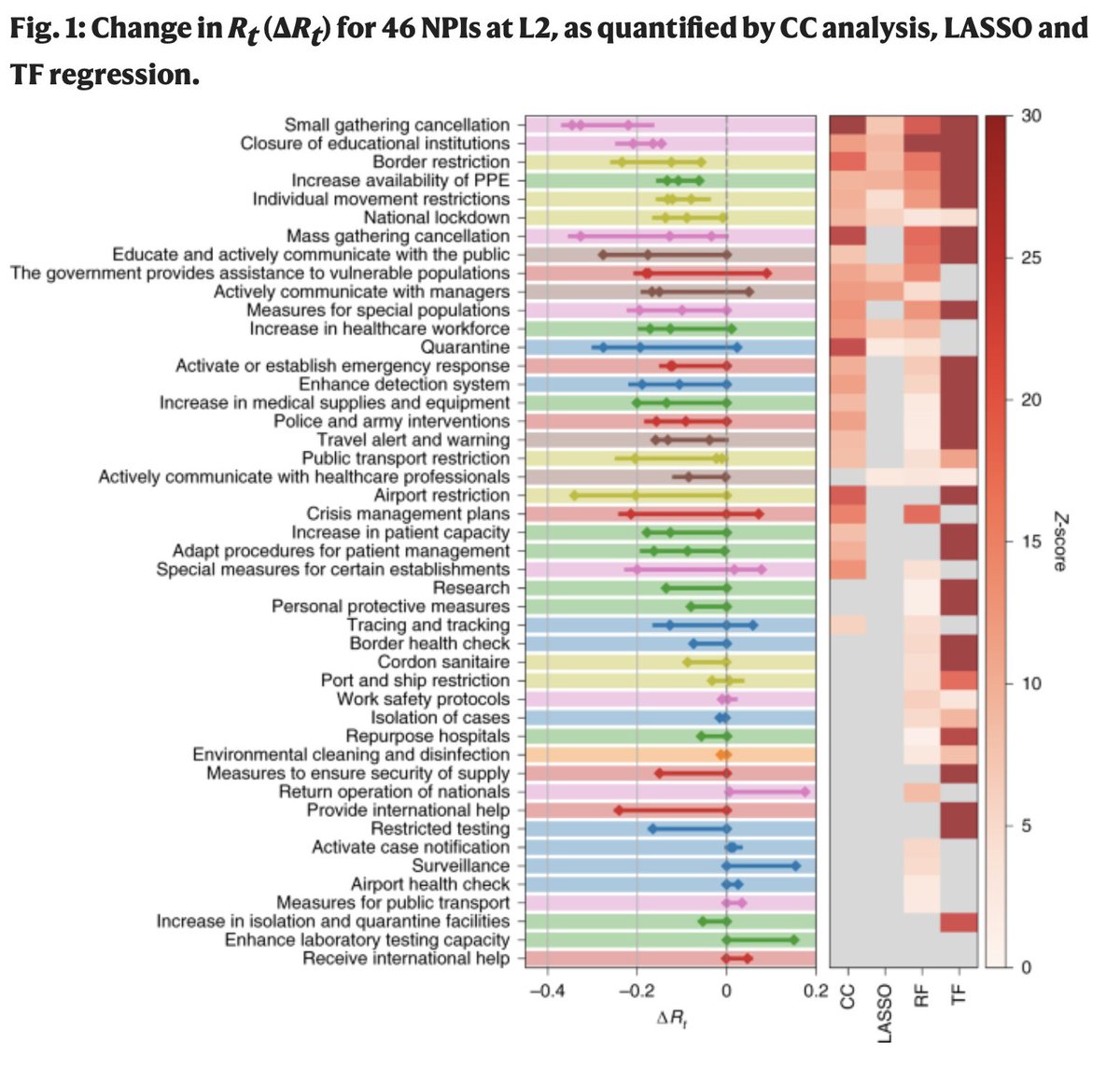Authors Prof Francois Balloux
7 days
30 days
All time
Recent
Popular
@mugecevik is an excellent scientist and a responsible professional. She likely read the paper more carefully than most. She grasped some of its strengths and weaknesses that are not apparent from a cursory glance. Below, I will mention a few points some may have missed.
1/
The paper does NOT evaluate the effect of school closures. Instead it conflates all ‘educational settings' into a single category, which includes universities.
2/
The paper primarily evaluates data from March and April 2020. The article is not particularly clear about this limitation, but the information can be found in the hefty supplementary material.
3/

The authors applied four different regression methods (some fancier than others) to the same data. The outcomes of the different regression models are correlated (enough to reach statistical significance), but they vary a lot. (heat map on the right below).
4/

The effect of individual interventions is extremely difficult to disentangle as the authors stress themselves. There is a very large number of interventions considered and the model was run on 49 countries and 26 US States (and not >200 countries).
5/

1/
I've recently come across a disinformation around evidence relating to school closures and community transmission that's been platformed prominently. This arises from flawed understanding of the data that underlies this evidence, and the methodologies used in these studies. pic.twitter.com/VM7cVKghgj
— Deepti Gurdasani (@dgurdasani1) February 1, 2021
The paper does NOT evaluate the effect of school closures. Instead it conflates all ‘educational settings' into a single category, which includes universities.
2/
The paper primarily evaluates data from March and April 2020. The article is not particularly clear about this limitation, but the information can be found in the hefty supplementary material.
3/

The authors applied four different regression methods (some fancier than others) to the same data. The outcomes of the different regression models are correlated (enough to reach statistical significance), but they vary a lot. (heat map on the right below).
4/

The effect of individual interventions is extremely difficult to disentangle as the authors stress themselves. There is a very large number of interventions considered and the model was run on 49 countries and 26 US States (and not >200 countries).
5/

"Herd immunity is back" may sound grand but I feel it is unnecessarily provocative and such sentiments won't help to engage in a much needed societal discussion. Incidentally, it is inaccurate.
1/
'Herd immunity' is neither a strategy nor a policy. It simply describes the mechanism by which an epidemic wanes before everyone in a population has been immunised through vaccination or infection. As such, 'herd immunity' is part and parcel of any vaccination campaign.
2/
It is fairly unlikely we'll have 'infection blocking' vaccines available for everyone in the near future. This is even true for the richest nations on earth. This has been acknowledged by the UK government, which doesn't plan to vaccinate most of its population.
3/
As #COVID19 won't be eradicated any time soon, the question is what is the best strategy to minimise morbidity and mortality whilst controlling #COVID19. Those fall in a continuum ranging from indefinite suppression (Zero COVID) to preferential shielding of the most at risk.
4/
How to deal with #COVID19 is a complex question that has no unique answer, only painful tradeoffs. Using inflammatory language, politicising and demonising those who disagree with us on the best strategy to reduce harm and deaths is, I believe, unhelpful.
5/
1/
Herd immunity is back. This article quotes its proponents, and then yours truly and @gregggonsalves on why in the absence of a clear way to protect the vulnerable from a raging storm of infection among the less vulnerable, it is a very dangerous idea 1/n https://t.co/5lkhaC34HK
— Bill Hanage (@BillHanage) October 6, 2020
'Herd immunity' is neither a strategy nor a policy. It simply describes the mechanism by which an epidemic wanes before everyone in a population has been immunised through vaccination or infection. As such, 'herd immunity' is part and parcel of any vaccination campaign.
2/
It is fairly unlikely we'll have 'infection blocking' vaccines available for everyone in the near future. This is even true for the richest nations on earth. This has been acknowledged by the UK government, which doesn't plan to vaccinate most of its population.
3/
As #COVID19 won't be eradicated any time soon, the question is what is the best strategy to minimise morbidity and mortality whilst controlling #COVID19. Those fall in a continuum ranging from indefinite suppression (Zero COVID) to preferential shielding of the most at risk.
4/
How to deal with #COVID19 is a complex question that has no unique answer, only painful tradeoffs. Using inflammatory language, politicising and demonising those who disagree with us on the best strategy to reduce harm and deaths is, I believe, unhelpful.
5/
